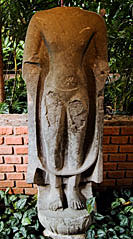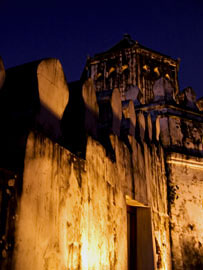Buddha on the Bounty
I went for a walk one evening along the concrete pathways that line the Chao Phraya river trying to work out a the solution to a broken bit of code that had gotten tangled up in my mind and in the project I was working on. I find that walking tends to work these sorts of things out; either that or they simply float away like butterflies in search of a different orchid.
 I was walking toward the park where the last Tai Chi class was finishing up and the lights had just come on at the Phra Sumen Fort; it was just after sundown, the sky still glowed with the hazy goodbye that lingers for about half an hour as a red glow in the west. The park and the fort are familiar to me now in an odd way as I have walked by them nearly every evening for the past two weeks. It’s strange how fast you can leave your familiar only to recreate it again wherever you go.
I was walking toward the park where the last Tai Chi class was finishing up and the lights had just come on at the Phra Sumen Fort; it was just after sundown, the sky still glowed with the hazy goodbye that lingers for about half an hour as a red glow in the west. The park and the fort are familiar to me now in an odd way as I have walked by them nearly every evening for the past two weeks. It’s strange how fast you can leave your familiar only to recreate it again wherever you go.
The idea that one day something in you snaps and you are simply unable to do what it was you did the day before seems a common thread in the lives of my fellow travelers. Sometimes it is not you that snaps but the world around you, however, usually if the world around you has snapped chances are you were close to snapping too. And by snapping I don’t mean anything necessarily bad. Though the word “snap” perhaps carries a negative connotation in this context, I do not mean it that way, this is not the sort of snap that postal workers were historically prone to (no offense to Andy’s dad or my mother’s cousin Dick), but a snap that is simply a hairpin turn of capacity.
The Siberian Farmer story was in my mind as I walked along the river though in truth I was wondering about Jim Thompson more than the possibly mythic Siberian farmer. For those that have never heard of him, Jim Thompson was an American born expat, who came to Thailand toward the end of WWII. He was sent as a military attache to help organize a Thai resistance and drive out the Japanese. But by the time Thompson got to Thailand the Japanese had already surrendered. He returned to Thailand shortly thereafter under the auspices of Allen Dulles’ OSS, the precursor to the CIA.
I haven’t been able to dig up much information on what it was that Thompson did for the OSS, but clearly he liked Thailand. Thompson stayed around for a while before returning to New York where he had been an architect. But something in him must have snapped because he returned to Thailand two years later with an interest in the then cottage industry of silk weaving. He proceeded to single handedly created the modern silk industry in Thailand and in the process became fantastically wealthy. He built, or rather collected, a beautiful traditional Thai home, gathering buildings from around the country and bringing them together in Bangkok. Today his house is a museum open to the public and I had recently visited the area, which was why Jim Thompson was on my mind.
But it wasn’t the house I was thinking of exactly, I was wondering what happened to Jim Thompson. In 1967 Thompson went on vacation with some friends in the Cameroon highlands in Malaysia. On the afternoon of March 27th his friends lay down to take a nap and Thompson said he was going for a walk. He was never seen again. What’s more there has never been a single shred of evidence of him ever found. It certainly wasn’t for lack of trying. Malaysia sent four hundred soldiers into the jungle to look for him. They found nothing. No evidence of foul play, whether it have been human or tiger playing the foul, and no evidence of, well, just no evidence at all.
It seems unlikely at this point that we will ever get to know what became of Thompson. It’s possible he was kidnapped. It’s possible a very thorough and hungry tiger ate him. It’s possible he willfully disappeared. His brief employment with the fledging CIA naturally leads to speculation about these things since any sort of legitimate trading operation would be just the thing the CIA loves to use as a cover, but the truth is no one knows and know one ever will, it’s as if Thompson simply slipped through a worm hole into that land beyond the sun.
 The house he left behind is gorgeous, but the real charm is the garden and its orchids. I wandered around the gardens which really aren’t that large for some time and then found a bench near a collection of orchids, where I sat for the better part of an hour, occasionally taking a photograph or two, but mostly thinking about how human orchids are. Of course in the west were most familiar with the ones on corsages, but Orchidaceae is one of the largest families in the plant kingdom and ranges in flower from tiny little ones the size of a mosquito to others the size of dinner plate. But the thing that struck me about them, which I had never noticed before is that the flowers of orchids are almost perfectly bilateral, just like the human body. Perhaps we are drawn to orchids because they reflect our symmetry and the symmetry we try to find in our lives.
The house he left behind is gorgeous, but the real charm is the garden and its orchids. I wandered around the gardens which really aren’t that large for some time and then found a bench near a collection of orchids, where I sat for the better part of an hour, occasionally taking a photograph or two, but mostly thinking about how human orchids are. Of course in the west were most familiar with the ones on corsages, but Orchidaceae is one of the largest families in the plant kingdom and ranges in flower from tiny little ones the size of a mosquito to others the size of dinner plate. But the thing that struck me about them, which I had never noticed before is that the flowers of orchids are almost perfectly bilateral, just like the human body. Perhaps we are drawn to orchids because they reflect our symmetry and the symmetry we try to find in our lives.
Symmetry implies a kind of duality, but dualities are out of vogue I suppose, Einsteinian notions being more cutting edge these days, and yet dualities still seem to pop up where ever you look. After staring for a while at the various red and yellow and purple orchids dropping gently at the end of their stalks, I started to think that maybe an Einsteinian world and a world of dualities are not so much at odds as we might think. Take the orchid for instance; on one hand its flower is bilateral, symmetrical, dual sides built around the tongue where insects land, and yet within this seeming constraint, the diversity of the flower size and color is relative to the species producing it.
Eventually I pulled myself away from the orchids and went to see the collections of Thai silk and artwork that the tour mentioned, but skipped over. Thompson, while not a Buddhist, was a great collector of Buddhist art. Thailand is saturated with images of the Buddha, saturated and venerated to the point that sometimes it seems like perhaps the message of Buddha has been overlooked in favor of his iconography.  Like most religious inspirers I believe it’s likely that Buddha would quietly shake his head at the things people do in his name, but some of the pieces at Thompson’s house were old enough and humble enough that they seemed like something the Buddha himself might have collected, were he a collector of art, which he most certainly was not. The one piece that particularly fascinated me was a headless, armless Buddha which the tour guide claimed was from the 7th century. After making my way through the various displays of very old silk, I returned to the headless statue of Buddha.
Like most religious inspirers I believe it’s likely that Buddha would quietly shake his head at the things people do in his name, but some of the pieces at Thompson’s house were old enough and humble enough that they seemed like something the Buddha himself might have collected, were he a collector of art, which he most certainly was not. The one piece that particularly fascinated me was a headless, armless Buddha which the tour guide claimed was from the 7th century. After making my way through the various displays of very old silk, I returned to the headless statue of Buddha.
I know I shouldn’t have and I never have in a museum, but something about the stone, the ragged edge where the head had once been contrasted with the smooth, worn surface the builder intended, I couldn’t help myself. After making sure no one was around, I ran my hands down the side of the statue along the broken edge and then across the polished carved portion. It was cool to the touch and though it may have been my overactive imagination, the stone felt somehow alive. It was then that I realized I don’t want to see any more images of the Buddha, that stone was as close to Buddha as we will ever get.
What made this Buddha different was its humility; it was broken, cracked, worn and somehow human. Perhaps that’s our ultimate fantasy of art, that our Pygmalion wishes be granted, that art might literally become alive to us. But it already is alive, the stone is living, living so slowly and quietly that it’s imperceptible, but living nonetheless. I’ve always found the duality in the question, ‘does life reflect art or art reflect life’ to be the most irritating of dualities. Clearly both happen. True the statue that stood before me was not as it had been designed, its head had come off by accident not purpose, but isn’t that why we make art, too see it interact with history? Without history, art becomes airless and stale, it’s for sale at the side of the street—a ten dollar trinket. Isn’t that the two way street, art does not reflect life it molds itself in life’s reflection and life does not reflect art, but recasts art with the passage of time. This headless Buddha is both a reflection of life, of Buddha and yet life has added its own truth, taken away the head, as if to say, be honest, you have no idea what the Buddha looked like, better that you should not even try.
 I sat down on a bench beside the fort to rest for a little while with thoughts of orchids, Jim Thompson, headless Buddha and Siberian Hysteria whirling round my head in an endless dialogue with one another when a headline from the morning’s paper jumped out at me, it had said that a team of researchers using some advanced facial recognition algorithm to calculate that the Mona Lisa is 83% happy. I don’t know much about algorithms except that there seems to be newer and shinier ones everyday. Arthur C. Clarke once said, “any sufficiently advanced technology is indistinguishable from magic.” Algorithms are, to lay-people like me, sufficiently advanced as to appear magical. So I reworded the news in my head: a team of researchers used magic to determine that the Mona Lisa is 83% happy. What a poor use of magic. Better to have lopped the head of Michelangelo’s‘ David so that in fourteen centuries we will remember what we don’t know.
I sat down on a bench beside the fort to rest for a little while with thoughts of orchids, Jim Thompson, headless Buddha and Siberian Hysteria whirling round my head in an endless dialogue with one another when a headline from the morning’s paper jumped out at me, it had said that a team of researchers using some advanced facial recognition algorithm to calculate that the Mona Lisa is 83% happy. I don’t know much about algorithms except that there seems to be newer and shinier ones everyday. Arthur C. Clarke once said, “any sufficiently advanced technology is indistinguishable from magic.” Algorithms are, to lay-people like me, sufficiently advanced as to appear magical. So I reworded the news in my head: a team of researchers used magic to determine that the Mona Lisa is 83% happy. What a poor use of magic. Better to have lopped the head of Michelangelo’s‘ David so that in fourteen centuries we will remember what we don’t know.
Thoughts?
Please leave a reply:
All comments are moderated, so you won’t see it right away. And please remember Kurt Vonnegut's rule: “god damn it, you’ve got to be kind.” You can use Markdown or HTML to format your comments. The allowed tags are
<b>, <i>, <em>, <strong>, <a>. To create a new paragraph hit return twice.